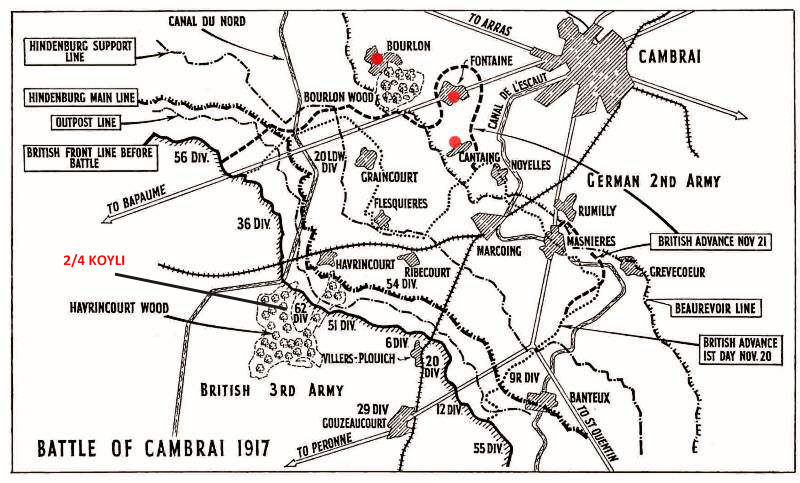
15715, King’s Own Yorkshire Light Infantry, 2nd/4th Battalion
Antony Jackson was born in Ossett in 1895, the second son of Horbury born George Jackson and his wife Catherine Mary (nee Brannock) who married in summer 1889. In 1901 George Jackson, his wife and five children were living at Manor Road, Ossett. He was working as a railway goods guard and, unusually for the time, Catherine Mary (Kate) was also working, as a rag sorter.
By 1904 the family, now with six children, had left Ossett for Normanton where George Jackson had gained employment as a church and school caretaker. In 1911, Anthony was aged 15 and he, and his elder brother, Ignatious, were both pony drivers in a coal mine. Anthony Jackson, aged 22, was to be killed in action in the Great War and the same fate befell his elder brother, Ignatious Jackson, aged 25.
Anthony’s army service record has not survived, but he enlisted at Normanton and joined the 2/4th Battalion, King’s Own Yorkshire Light Infantry with service number 15715. He embarked for France on the 26th August 1915 and died of his wounds on the 21st November 1917. Like his brother, Ignatious, he was an army volunteer. He was posthumously awarded the 1914/15 Star to acknowledge his service overseas before 31st December 1915 and he was also awarded the British and Victory medals.
The Territorial 2nd/4th Battalion, KOYLI was formed at Wakefield on the 30th September 1914 as a second line unit. On the 1st March 1915 they moved to Bulwell and were attached to 187th Brigade in 62nd (2nd West Riding) Division. They moved in April 1915 to Strensall and in May to Beverley, going on in November to Gateshead, in January 1916 to Larkhill and in June 1916 to Flixton Park near Bungay. They moved again in October 1916 to Wellingborough and landed at Le Havre, France on the 15th January 1917.
It is likely that Private Anthony Jackson was killed during intense fighting at the Battle of Cambrai, between the 20th November and the 6th December 1917. On the 20th November, the opening day of the battle, 62 Division broke through both the Hindenburg Main and Support Lines, occupying Havrincourt and Graincourt, and by the end of the day had crossed the Bapaume to Cambrai road (N30). This represented an advance of 7 km in one day, an outstanding achievement at that time.
The next day the division took Anneux and the tanks entered Bourlon Wood, but the infantry were too exhausted to follow them. The effort was aimed at Bourlon Ridge. Fighting was fierce around Bourlon and at Anneux (just before the woods) was costly. German counter-attacks squeezed the British out of Moeuvres on the 21st November and Fontaine on the 22nd November; when Anneux was taken, the 62nd Division found themselves unable to enter Bourlon Woods. The British were left exposed in a salient. Haig still wanted Bourlon Ridge and eventually the exhausted 62nd Division was replaced by the 40th Division.
Like his brother, Anthony Jackson is not remembered on any Ossett Memorial or Roll of Honour perhaps because he and his family had left Ossett in about 1904. He is remembered in this 2014 biography and Roll of Honour because the Commonwealth War Graves Commission and/or the “U.K. Soldiers who Died in the Great War 1914-1918” listing records him as born or residing in Ossett.

Private Anthony Jackson died on the 21st November 1917, aged 22 years, the son of George and Catherine Jackson, of 3, Dalefield Rd., Normanton, Yorkshire. He is buried at grave reference II. F. 4. at the Rocquigny-Equancourt Road British Cemetery, Manancourt,1 Somme, France. Rocquigny and Equancourt are two villages in the Department of the Somme, some 13 kilometres north of Peronne and 12 kilometres south-east of Bapaume. Rocquigny and Equancourt are approximately 8 kilometres apart and the Rocquigny-Equancourt British Cemetery lies about halfway between the two villages on the north side of the road just west of the crossing road from Etricourt to Ytres.
Etricourt was occupied by Commonwealth troops at the beginning of April 1917 during the German withdrawal to the Hindenburg Line. It was lost on the 23 March 1918 when the Germans advanced, but regained at the beginning of September.
The cemetery was begun in 1917 and used until March 1918, mainly by the 21st and 48th Casualty Clearing Stations posted at Ytres, and to a small extent by the Germans, who knew it as “Etricourt Old English Cemetery”. Burials were resumed by Commonwealth troops in September 1918 and the 3rd Canadian and 18th Casualty Clearing Stations buried in it in October and November 1918.
The cemetery contains 1,838 Commonwealth burials and commemorations of the First World War. 21 of the burials are unidentified and nine Commonwealth graves made by the Germans which cannot now be found are represented by special memorials. The cemetery also contains 198 German war burials and the graves of ten French civilians.
References: